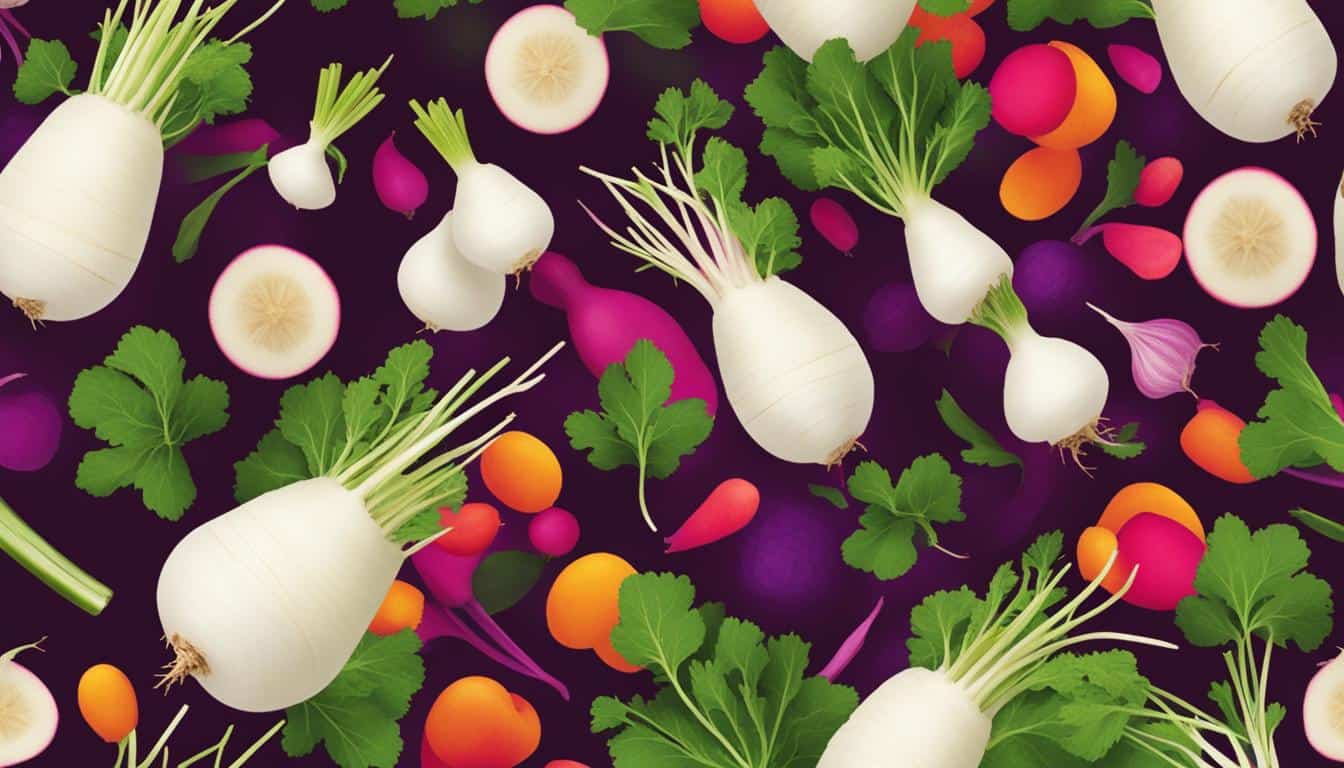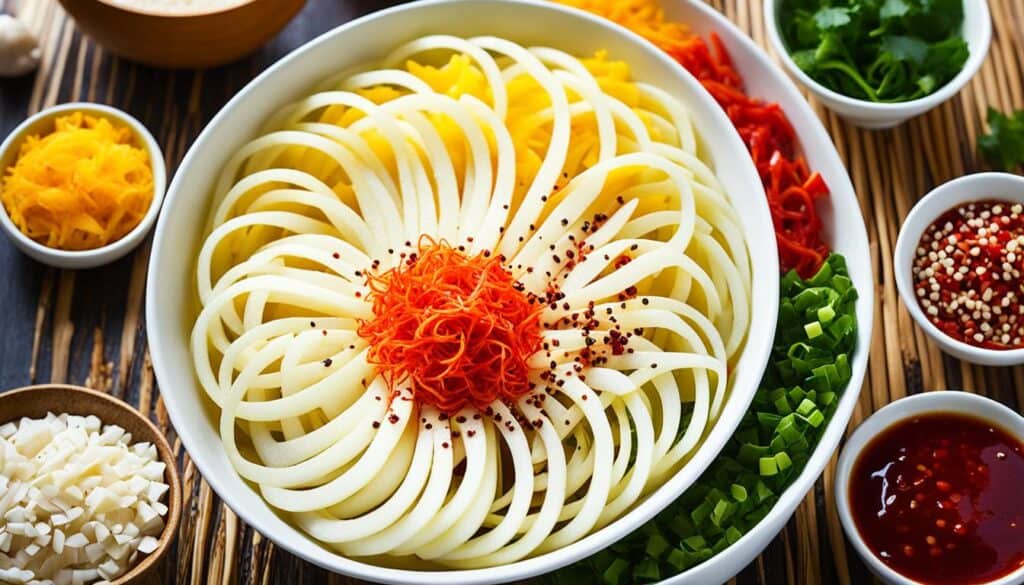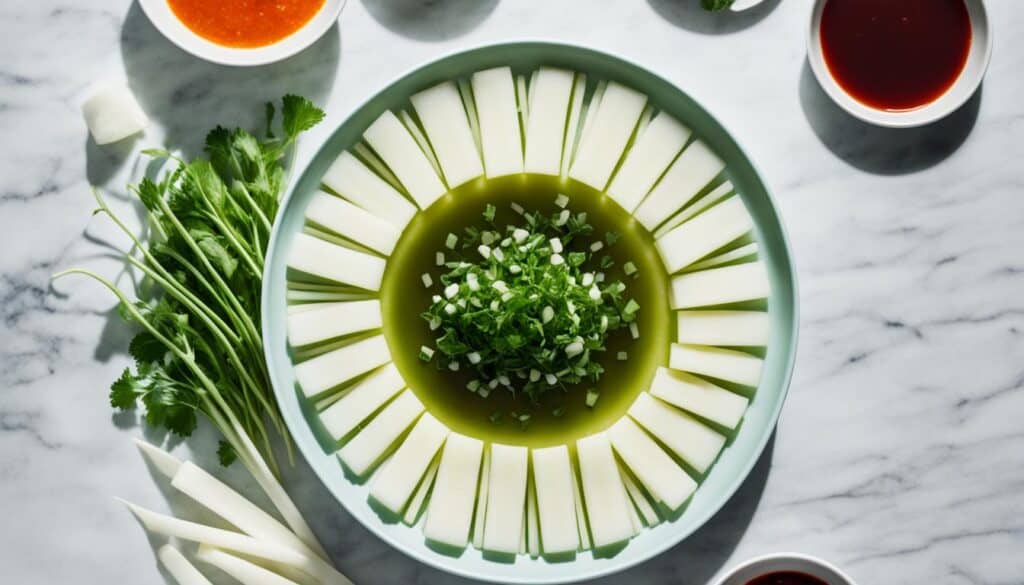Did you know that daikon radish, a versatile and nutritious vegetable, offers a wide range of health benefits? From supporting digestion to regulating blood sugar levels, daikon radish can have a positive impact on your overall health.
Daikon radish is not only packed with essential vitamins and minerals like folate, potassium, vitamin C, and vitamin B6 but also low in calories and fat, making it a great addition to a weight loss diet. Its hydrating properties and beneficial effects on the skin further enhance its appeal.
If you’re curious about the nutritional value of daikon radish, its culinary uses, or even how to grow it at home, you’ve come to the right place. In this article, I’ll take you through everything you need to know about daikon radish, from the health benefits to delicious recipes.
Key Takeaways:
- Daikon radish is a nutrient-dense vegetable high in vitamins and minerals.
- Its health benefits range from supporting digestion to strengthening the immune system.
- Daikon radish can be used in various culinary dishes, offering a unique flavor and texture.
- You can easily grow daikon radish at home for a fresh and organic supply.
- Try out delicious daikon radish recipes to explore its versatile flavors.
Nutritional Value of Daikon Radish
Daikon radish is packed with nutrients that are beneficial for the body. In a 1-cup serving of raw, sliced daikon radish, there are approximately 19 calories, 0.8g of protein, 4g of carbohydrates, 1.9g of fiber, and 0.1g of fat. The radish is a rich source of folate, which is important for white and red blood cell synthesis, potassium, which helps regulate fluid balance in the body, vitamin C, which strengthens blood vessel walls, and vitamin B6, which plays a role in metabolism. Daikon radish offers a diverse range of nutrients that can contribute positively to overall health and well-being.
| Nutrient | Amount per 1-cup Serving (Raw, Sliced) |
|---|---|
| Calories | 19 |
| Protein | 0.8g |
| Carbohydrates | 4g |
| Fiber | 1.9g |
| Fat | 0.1g |
Daikon radish not only adds a crunch to your meals, but it also provides essential nutrients to support your overall health. The low calorie and fat content make it a great choice for weight-conscious individuals. Its fiber content aids digestion and promotes a healthy digestive system. In addition, the rich vitamin and mineral content of daikon radish contribute to the proper functioning of various bodily processes.
“Daikon radish is packed with nutrients that are beneficial for the body.”
Uses of Daikon Radish
In addition to its nutritional value, daikon radish has various culinary uses. Its crisp texture and mild flavor make it a versatile ingredient in both cooked and raw dishes. Daikon radish can be sliced and added to salads for a refreshing crunch or grated and used as a condiment. It can be pickled, roasted, or stir-fried as a side dish. In many Asian cuisines, daikon radish is a staple ingredient in soups, stews, and braised dishes. Its versatility and ability to absorb flavors make it a popular choice among chefs and home cooks alike.
- Add sliced daikon radish to your next salad for a refreshing and crunchy bite.
- Try pickling daikon radish for a tangy and flavorful condiment.
- Roast daikon radish alongside other vegetables for a delicious and nutritious medley.
Whether you’re looking to add a pop of flavor to your meals or enjoy the health benefits of daikon radish, there are endless possibilities when it comes to incorporating this versatile vegetable into your cooking.
Health Benefits of Daikon Radish
Daikon radish offers a plethora of health benefits, thanks to its impressive nutritional profile. Let’s take a closer look at some of the ways daikon radish can promote your overall well-being:
Sulfur-Containing Compounds for Cell Protection
The glucosinolates present in daikon radish, known for their sulfur content, play a crucial role in protecting cells from genetic mutations and potential cancer development.
Promoting Digestive Health
The fiber content in daikon radish promotes a healthy digestive system, preventing conditions like constipation and digestive disorders, including irritable bowel syndrome.
Antifungal Properties for Health Defense
Daikon radish exhibits antifungal properties, making it an effective defense against Candida bacteria, a common cause of yeast infections.
Blood Sugar Regulation and Immune Support
Incorporating daikon radish in your diet can help regulate blood sugar levels and improve insulin response and glucose metabolism. Additionally, it enhances immune system function, strengthening your body’s natural defense mechanisms.
Contributing to Hydrated, Healthy Skin
Daikon radish’s high water content helps keep your body hydrated. The vitamin C it contains promotes healthy skin, contributing to a radiant complexion.
Supporting Heart Health and Balancing Blood Pressure Levels
The presence of anthocyanins in daikon radish supports heart health, while the vegetable’s potassium content helps balance blood pressure levels.
A Complete Table of Daikon Radish Health Benefits:
| Health Benefit | Description |
|---|---|
| Cell Protection | The sulfur-containing compounds in daikon radish protect cells from genetic mutations and potential cancer development. |
| Digestive Health Promotion | The high fiber content in daikon radish supports a healthy digestive system and prevents constipation and digestive disorders. |
| Antifungal Properties | Daikon radish exhibits antifungal properties, making it effective against Candida bacteria. |
| Blood Sugar Regulation | Including daikon radish in your diet can help regulate blood sugar levels and improve insulin response and glucose metabolism. |
| Immune System Support | Daikon radish enhances immune system function, strengthening your body’s natural defense mechanisms. |
| Healthy Skin | The vitamin C in daikon radish contributes to healthy skin, while its high water content helps keep your body hydrated. |
| Heart Health | The presence of anthocyanins in daikon radish supports heart health. |
| Blood Pressure Regulation | Daikon radish’s potassium content helps balance blood pressure levels. |
Culinary Uses of Daikon Radish
Daikon radish is a versatile vegetable that can be used in a variety of culinary preparations. Its unique taste and texture make it an excellent addition to dishes from various cuisines.
Here are some ways you can enjoy daikon radish:
- Pickled Daikon Radish: Pickling daikon radish is a popular way to preserve and enhance its flavors. The tangy and crisp pickled daikon radish can be enjoyed as a side dish or used as a condiment in sandwiches and wraps.
- Roasted Daikon Radish: Roasting daikon radish, along with other vegetables, brings out its natural sweetness and adds a delightful crunch to any vegetable medley.
- Salads: Slicing daikon radish and adding it to salads can provide a refreshing and crunchy element to your greens. Its mild flavor pairs well with a variety of salad dressings and other salad ingredients.
- Asian Cuisine: In Asian cuisine, daikon radish is commonly used in stir-fries, soups, and braised dishes. Its crisp texture and mild flavor complement the savory and aromatic elements of these dishes.
- Condiment: Grating daikon radish and using it as a condiment can add a refreshing and spicy kick to your stews, curries, and other flavorful dishes.
Adding daikon radish to your culinary repertoire opens up a world of flavors and textures. Its versatility makes it a great choice for both traditional and creative recipes.
Try this refreshing Daikon Radish Salad recipe:
“This Daikon Radish Salad is a delicious and healthy dish that showcases the crisp and mild flavors of daikon radish. It’s quick and easy to prepare, making it a perfect side dish for any meal.”
| Ingredients | Instructions |
|---|---|
|
|
This refreshing Daikon Radish Salad is a perfect side dish or light lunch option. The combination of julienned daikon radish, carrot, and cucumber creates a harmonious blend of flavors, while the sesame dressing adds a delightful nuttiness. Sprinkle with toasted sesame seeds for a beautiful presentation.
Explore the culinary possibilities of daikon radish and experiment with different recipes to enjoy this versatile vegetable to the fullest!
Growing Daikon Radish
Daikon radish, a cool-season vegetable, can be easily grown in home gardens. By following a few simple steps, you can enjoy a fresh and organic supply of this nutritious vegetable right in your backyard.
Soil Requirements
Daikon radish thrives in well-drained soil with a pH level ranging from 5.8 to 6.8. Prepare the soil by removing any weeds or debris and loosening it to a depth of at least 6 inches to facilitate root growth.
Tip: Conduct a soil test to determine the pH level and adjust it if necessary by adding lime or sulfur.
Planting Daikon Radish Seeds
Directly sow daikon radish seeds into the soil, placing them about half an inch deep and one inch apart. Opt for a sunny spot in your garden that receives at least six hours of direct sunlight daily.
Tip: Consider using row covers to protect the seeds from birds or pests during the germination process.
Watering
Regular watering is essential for the seeds to germinate and grow into healthy radish plants. Keep the soil consistently moist, but avoid overwatering, as it can lead to rotting or fungal diseases.
Harvesting Daikon Radish
Daikon radishes are typically ready to harvest around 24 to 30 days after planting. Gently pull the radish from the ground, making sure to remove any plant debris attached to the roots. Enjoy the harvest in your favorite daikon radish recipes.
Tip: Don’t let the radishes grow too large, as they may become woody and lose their desirable flavor and texture.
| Step | Details |
|---|---|
| 1 | Prepare well-drained soil with a pH level of 5.8 to 6.8 |
| 2 | Sow daikon radish seeds half an inch deep and one inch apart |
| 3 | Keep the soil consistently moist |
| 4 | Harvest radishes when mature, around 24 to 30 days after planting |
Daikon Radish in Cuisine
Daikon radish is a staple in many cuisines, particularly in Asian cooking. Its unique flavor and texture make it a versatile ingredient that adds depth to a variety of traditional dishes.
In Japanese cuisine, daikon radish is celebrated for its crisp and refreshing qualities. It is commonly used in dishes like daikon salad, where the radish’s natural sweetness complements the tangy dressing. Additionally, pickled daikon radish is a popular accompaniment to meals, providing a burst of flavor and balancing the richness of other dishes. Sliced daikon radish is also often served as a topping for sashimi, adding a delicate crunch to each bite.
Korean cuisine incorporates daikon radish in numerous ways, most notably in kimchi. This traditional fermented dish features a combination of vegetables, including daikon radish, that are seasoned with spices and left to ferment for a distinct tangy flavor. Daikon radish is also a key ingredient in radish soup, a comforting and nourishing dish enjoyed throughout the year.
Chinese cuisine embraces daikon radish’s versatility by using it in a variety of cooking methods. It can be stir-fried with other vegetables to create a vibrant and flavorful dish. Daikon radish is also commonly used in braised dishes, where it absorbs the rich flavors of the sauce or broth. Furthermore, it is a popular ingredient in hearty soups, adding both flavor and texture to the overall composition.
Indian cuisine incorporates daikon radish in various ways. One notable dish is Mooli Saag, which braises the radish leaves with spices and other ingredients, creating a flavorful and nutritious side dish. Daikon radish is also utilized in stir-fries and curries, enhancing the depth of flavor and providing a satisfying crunch.
With its diverse applications in different culinary traditions, daikon radish continues to captivate taste buds with its unique taste and texture.
Daikon Radish Recipes
Looking for some delicious ways to incorporate daikon radish into your meals? Look no further! I’ve got some mouthwatering recipes that showcase the versatility and flavor of daikon radish.
Mullangi/Radish Stir Fry
One popular recipe is the Mullangi Stir Fry, a delectable South Indian curry that features daikon radish as the star ingredient. The radish is thinly sliced and cooked with a blend of fragrant spices, creating a savory and aromatic dish that pairs perfectly with rice or roti.
Mooli Saag
Another exciting recipe is Mooli Saag, where the radish leaves are braised with a medley of spices and other ingredients. This dish brings out the natural flavors of the daikon radish leaves and creates a delightful side dish that complements any Indian meal.
Aside from these traditional recipes, daikon radish can be used in various other culinary creations. Here are a few ideas:
- Add grated daikon radish to salads for a refreshing crunch.
- Slice daikon radish and stir-fry it with other vegetables for a nutritious side dish.
- Incorporate daikon radish into soups and stews for added flavor and texture.
- Grate daikon radish and use it as a condiment or topping for sandwiches and wraps.
With daikon radish, the possibilities are endless. Let your creativity soar and experiment with this versatile vegetable to create unique and flavorful dishes.
Explore these recipes and transform your cooking with the delightful flavors of daikon radish. Whether you’re a seasoned chef or a culinary enthusiast, daikon radish is sure to add a new dimension to your meals. Give these recipes a try and savor the deliciousness of daikon radish in every bite!
Daikon Radish and Traditional Medicine
Daikon radish has been a vital component of traditional medicine, specifically in Ayurveda and Traditional Chinese Medicine, due to its remarkable medicinal properties. It is revered for its potential to address various ailments, including sore throat, bile disorders, and inflammation. The therapeutic effects of daikon radish are attributed to the enzymes and compounds present in this remarkable vegetable. Traditional medicine holds daikon radish in high regard for its ability to support overall health and well-being.
In Ayurveda, daikon radish is valued for its cooling and digestive properties. It is believed to pacify excess heat and inflammation in the body, aiding in the treatment of conditions such as heartburn and acid reflux. Additionally, daikon radish is recommended for its potential to promote healthy digestion and alleviate digestive disorders.
In Traditional Chinese Medicine, daikon radish is regarded as a powerful natural remedy for addressing excessive phlegm and dampness in the body. It is commonly used to alleviate symptoms associated with coughs, congestion, and sinusitis. Due to its diuretic properties, daikon radish is also believed to help eliminate excess fluid from the body and reduce swelling.
“Daikon radish has played a significant role in traditional medicine, offering natural remedies for various health issues. Its healing properties have been cherished for centuries, and it continues to be a valuable component of holistic healing.”
Both Ayurveda and Traditional Chinese Medicine emphasize the importance of maintaining balance and harmony within the body. Daikon radish is considered an essential ingredient in herbal formulations and dietary recommendations aimed at promoting optimal health and preventing diseases.
Incorporating daikon radish into your diet can be a simple yet effective way to tap into its potential health benefits. Whether consumed raw, cooked, or as a natural herbal remedy, daikon radish provides a natural approach to supporting overall well-being.
Conclusion
Daikon radish is truly a nutritional powerhouse that brings a wealth of benefits to the table. Packed with essential vitamins and minerals, this versatile vegetable promotes digestion, supports the immune system, and regulates blood sugar levels. The culinary possibilities are endless, as daikon radish can add a delightful flavor and texture to various dishes including salads, stir-fries, and soups. It’s even easy to grow at home, ensuring a fresh and organic supply.
With daikon radish, you can enhance the taste and nutrition of your meals. Whether you’re looking to maintain a healthy weight, boost your immune system, or enjoy a delicious addition to your recipes, daikon radish is a valuable ingredient to consider. Explore the diverse range of daikon radish recipes available and let your culinary creativity soar.
So why not give daikon radish a try? Incorporate this nourishing vegetable into your diet and reap the benefits it has to offer. From its remarkable health properties to its broad culinary uses, daikon radish is a true gem in the world of vegetables. Start enjoying the benefits of daikon radish today and savor its delightful flavors in your favorite recipes!









Leave a Reply